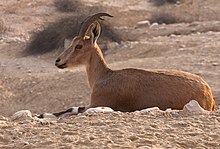Nubian ibex
| Nubian ibex | ||||||||||||
|---|---|---|---|---|---|---|---|---|---|---|---|---|

Nubian Ibex ( Capra nubiana ) |
||||||||||||
| Systematics | ||||||||||||
|
||||||||||||
| Scientific name | ||||||||||||
| Capra nubiana | ||||||||||||
| Cuvier , 1825 |
The Nubian ibex , also Nubian ibex or Nubian Ibex ( Capra nubiana ), is a living in the Arabian Peninsula and in northeast Africa Paarhuferart . It is closely related to the Alpine Ibex and is often listed as its subspecies.
features
Compared to Alpine Ibex, Nubian Ibex are smaller and lighter. They reach a head body length of 105 to 125 centimeters, plus a 15 to 20 centimeter long tail. Her shoulder height is 65 to 75 centimeters and her weight is 25 to 70 kilograms; Males become significantly heavier than females. The fur is sand-colored on the top and lighter, almost white, on the underside. There are characteristic black and white drawings on the legs. In addition to their dark beards, the males in particular also have an eel line . Their necks, chest, shoulders and flanks turn dark brown to black during the rutting season. Both sexes have horns, as with all goats , those of the males are considerably larger. In the females they reach a maximum of 35 centimeters and are comparatively thin, in the males they can be up to 1.2 meters long, whereby when fully grown they then form an almost complete arch with tips pointing forward.
distribution and habitat
Nubian ibex are native to the Arabian Peninsula and northeastern Africa . In the Levant and on the Arabian Peninsula they occur in Israel , Jordan , Saudi Arabia , Yemen and Oman , in Syria and Lebanon they are extinct. In northeast Africa they inhabit the Red Sea coast of Egypt , Sudan and Eritrea . However, its range is very fragmented and fragmented. The habitat of these animals are rocky desert regions.
Way of life
In contrast to many other desert-dwelling animals, Nubian ibex are not nocturnal and rely on regular drinking. In the summer months the animals spend the night in the open, in winter they go to caves or overhangs. They are herbivores that feed on grasses, herbs and other things.
Females live in groups of 10 to 20 animals with their offspring up to the age of three. Males live in bachelors or solitary groups most of the time. In the mating season, usually in October, the bucks seek connection with a herd of females and fight fiercely with other males for the mating privilege.
After a gestation period of around five months, the female usually gives birth to one or two young in March. They stay with their mother until they are around three years old. They become sexually mature at the same age; due to the social structure, the first reproduction often takes place a few years later.
threat
The main threats to the Nubian ibex are hunting and poaching, and there is also the displacement from their habitats by domestic goats, camels or feral donkeys. In some countries, such as Israel and Saudi Arabia, they are fully protected, although the implementation of protective measures is often poor. In many countries the populations have dropped to a few animals, but there are no current figures. The IUCN lists the species as endangered ( vulnerable ).
Systematics
The Nubian Ibex is closely related to the Alpine Ibex. Together with the Siberian Ibex , these three populations are often combined into one species, the "Common Ibex". Other ibexes such as the Iberian or Ethiopian ibex , however, are not as close to them and are generally recognized as separate species. Whether the Nubian ibex is a separate species ( Capra nubiana ) or a subspecies of the "common ibex" (as Capra ibex nubiana ) is a question of definition; the system here follows Wilson & Reeder (2005) and lists it as a separate species.
literature
- Ronald M. Nowak: Walker's Mammals of the World . Johns Hopkins University Press, 1999 ISBN 0-8018-5789-9
- DE Wilson, DM Reeder: Mammal Species of the World . Johns Hopkins University Press, Baltimore 2005. ISBN 0-8018-8221-4
Web links
- Photos, distribution map and further information
- Capra nubiana onthe IUCN Red List of Threatened Species . Retrieved July 22, 2009.



